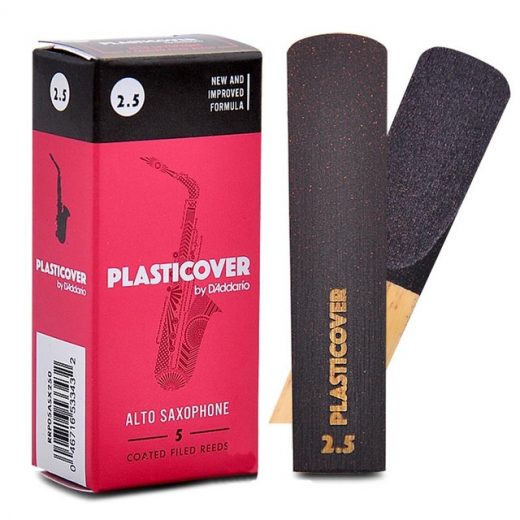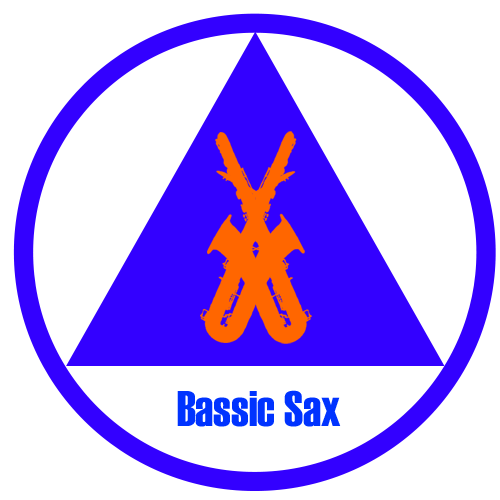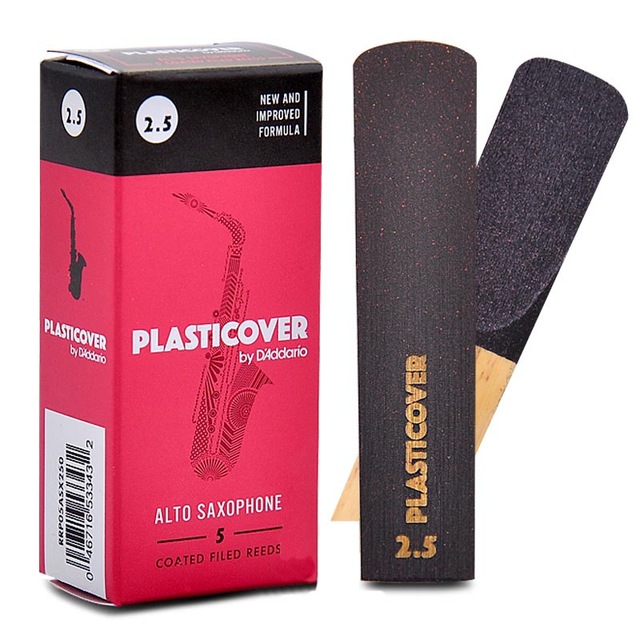 I have been using premium synthetic reeds exclusively since 1998. Why? Simply put, because I double in most bands that I play in, and can’t be worried about getting my reed wet before putting the sax or clarinet to my lips and blowing my first note. This is especially true in pit work where you sometimes have less than two bars to switch horns and play the next series of notes.
I have been using premium synthetic reeds exclusively since 1998. Why? Simply put, because I double in most bands that I play in, and can’t be worried about getting my reed wet before putting the sax or clarinet to my lips and blowing my first note. This is especially true in pit work where you sometimes have less than two bars to switch horns and play the next series of notes.
The second reason I play premium synthetics exclusively is because I don’t want the hassles of fiddle f#*!ing around cane. Been there; done that; bought the T-shirt. Life is too short to worry about the break-in period; sealing the pores of the reed; filing; etc, etc… You know, all that stuff you were taught by your instructor when he/she taught you how to look after your reeds to make them play well and last. (And that was in old days, when a box of good quality cane reeds didn’t cost the equivalent of a night’s work at a club.)
Légère reeds don’t work on necessarily every horn
For the past 8 or so years I have been using Légère reeds exclusively on all my saxophones and clarinets. For the most part I use the Signature Series, and have never had a problem with them on the 20+ instruments that have had them fitted to the mouthpieces…. That is until this month.
If you subscribe to The Bassic Sax Blog, you know that I got an Olds Super tenor from Chadd at World Wide Sax, and that my tech David Gsponer at Matterhorn Music restored it for me. Since I got the Olds back from David, I took it to exactly one rehearsal of the jazz combo I play in. It sounded beautiful playing both the lead lines, and background fills for all five decades of jazz music we play.
After its outing at the Dizzy Souls rehearsal however, the horn started to leak, and suffer from significant intonation issues. Due to David’s schedule, and my re-injured back, I wasn’t able to get the Olds back in for its post-restoration tune-up until earlier this week.
On Wednesday David found and fixed quite a few serious leaks on the horn, but when I tried the non-leaking Olds, the intonation was still horrendous. Anything above A2 was between 40 to 50 cents sharp. Anything in the low-end of the horn was flat roughly the same amount.
I tried 5 to 6 new mouthpieces David had in stock, plus a few vintage pieces as well. These pieces all had different chamber types; baffles; as well as tip openings. In short, they were all very different, but they, along with my vintage Dukoff 7*, all produced the same horrendous intonation described above.
Then it came to me: The only variable we hadn’t ruled out was the type of reed. I had already swapped out my Légère Signature for a brand new one to make sure it wasn’t simply a “fatigue” thing that the reeds can suffer from as they get too many hours of use. Could it therefore be that the Olds simply didn’t like synthetic reeds?
I did have a Rico Plasticover in a Reed Guard, so  I tried that. Low and behold, near perfect intonation on any mouthpiece I re-tried at David’s shop.
I tried that. Low and behold, near perfect intonation on any mouthpiece I re-tried at David’s shop.![]()
David had no explanation for this. In all his years of experience in restoring, overhauling, and working on instruments, he had never seen a saxophone respond this extremely to synthetic reeds. Over the past few days I have continued the experiments at home by trying a variety of mouthpieces that I have here. As long as I use a cane reed, no intonation issues manifest themselves with the Olds.
I am still experimenting with mouthpieces to find the one that brings out the best sound out of this vintage baby. One that is showing a fair amount of promise is a very vintage Tonalin 3* that David had stored in a box.
Like so many other Tonalins of the era, its shank had suffered a crack. It had however, been fixed a long time ago, and reinforced on the outside with some kind of tape. If I do end up using it as my main piece for the Olds, David will make it a brass band like the English-made ones had.
However, I do have a newer, unnumbered Tonalin, as well as a couple Ebolins, as well as a number of other vintage pieces to spend some time on to see how they play on the Olds. Now that the reed issue has been sorted out, it’s a whole new ballgame.
I must admit I am enjoying the experimentation phase at the moment. The Olds really is an animal all to itself. It is unlike any other vintage tenor I have played before. It has some quirks and foibles that seem particular to it, but I’m not sure how much is the horn itself, and how much a role the oversized resos might be playing… But that is an article for another day.
Other variables to try
Now you cane purists out there are likely cringing, or perhaps already typing a response to me in all caps along the lines of: PLASTICOVER REEDS ARE NOT TRUE CANE!!!!
OK, sure I’ll give you the argument that the coating does change the properties of the reed enough to have it fundamentally behave and sound differently than uncoated cane… But then that’s the entire point of using them.
I do have boxes of conventional cane reeds that I have left over from years ago when I still used cane—when decent cane reeds were not scarcer than snow in the Florida Everglades. 😉 And to be fair, I ought to try at least one or two of those to see how the Olds Super performs with those compared to the Plasticover.
Final thoughts
 I talked with Chadd on Friday, and the Olds Super alto he has for sale at WWS is similar in some of its tonal peculiarities to what I have encountered with my tenor.
I talked with Chadd on Friday, and the Olds Super alto he has for sale at WWS is similar in some of its tonal peculiarities to what I have encountered with my tenor.
Although he has not tested it with a synthetic reed to see what its intonation is like vis-à-vis a cane reed, he has noticed that it too seems to want to default to a 1940s saxophone sound. It too responds best with certain kinds of mouthpieces. That said, a pro player from Seattle recently play-tested a bunch of horns at WWS, and the Olds Super was one of them. This player used an alto Guardala MP, and the horn seemed to play quite well with it.
I remember when I play-tested that same Olds Super alto at WWS. I tried both of my standard alto MPs (a Runyon Custom and a Meyer), but neither made me like the horn enough to buy it. In hindsight, I’m wondering if it was the Légère reeds I was using?
When all is said and done, it’s almost as if the Olds Super is a very classy 1940s woman, who does not like to be tarted up with extreme MPs, and fake reeds.




It’s really the ligature. Then it’ll be the screws in the ligature. 😀
I also remember the guy that mentioned putting a hole in your reed. I think that was on SOTW.
I haven’t used Rico Plasticover reeds in probably 25 years. The two things I remember were that they tasted terrible and they warped very easily.
Nice writeup!
Never much success with Legere reeds for some reason – at least for sax. I do use on clarinet and bari for sax. Yup, all of the purists out there can scoff, but for pit work and jazz (solo and ensemble), synthetic reeds work for me.
Am told, my sound is great and usually there is surprise when I explain my reed setup. As well, within my group of sax players, synthetic reeds continue to be the go to reed for most pro work.
Great laugh about your “life is too short” comment. Before synthetics, the time spent on getting a reed to play (and the sorrow when a great cane reed splits) was excessive…
I had a 10m that only tuned with a Tonalin also
Just read your post .Very helpful comments to add to my own experiences .About the cane reeds,,Yes the quality we had in the 60s is not there anymore . There was a Boosey and Hawkes OSCILLATOR cane reed with a small round depression on the reverse side that I found to be just fine for funky music . At present with my 1958 HOHNER PRESIDENT TENOR I use a 1960s metal BERG LARSEN mpc 95-2-sms with Rico Plasticover 2.5 reeds .But out of a box of five reeds sometimes I can find only one or two good reeds. Maybe a Berg mpc of different specifications from 100 to 110 tip opening would work well with the Rico Plasticover reed.on your OLDS. BTW I have acquired a 1960 TONE KING Tenor with the angel wing bell key guard .as well as another 1960 HOHNER PRESIDENT Tenor in fine condition from Germany The TONE KING is full of power for be bop .All the best .
I’ve been using Légère reeds for some time with mixed results. However, I got serious a few months ago and *think* I have them working … well, I hope so! Here’s my trick: put a small dab of cork grease on the back of the reed where it meets the mpc table. I only have to do this once every 4 or 5 plays; the grease doesn’t seem to wipe off.
I know it sounds stupid … but it works for me.
Good luck.
This means the table of your mouthpiece isn’t flat. Cane reeds swell with moisture and take up the gap, but synthetics don’t. You can continue using grease (it shouldn’t hurt anything) but you might also try to find a ligature that works better, by putting pressure where it needs to be. I don’t mean buying and trying, just going through everything you have or can borrow. If you have (or can borrow) a Winslow, you can also try moving the contact points around.
I would agree with you Mal, if it weren’t that EVERY mouthpiece I tried—both those in my stash at home, and brand new ones that my tech had in his shop—reproduced EXACTLY the same intonation problems. I would find it difficult to believe that approx. 15 MPs all have non-flat tables—tables that do not effect the intonation on any of my other saxophones.
Now a funny thing happened the other night at my big band rehearsal. I took the Olds with me so that our tenor player could try it. He has used the same Claude Lakey MP for 30+ years, and combines it with Vandoren reeds.
The horn played beautifully for him with no intonation problems, and with no issues around the low C where I thought there might be issues with the size of reso. Mark noted that he didn’t have to make any different facial adjustments than he made for his Mark VI. He just played it like he would his Selmer. It sounded perfect.
I have reached out to the Claude Lakey company to get their advice about which MP tip opening to order based on my other MPs. I am going to order a new one and try it out just to see what it is like. It strikes me that it has the capability of providing me with more of the sound that I am used to getting.
The Brilhard Tonalin, while nice, is rather soft and dark, and doesn’t give me that power and brilliance that I’m used to. The Lakey is more like a Dukoff in that it can live in both worlds: rice, lush ballads, and screaming, edgy loud solos when required.
I wasn’t responding to you, Helen. I was answering Bob van der Poel regarding cork grease on the mouthpiece. Sorry for any confusion that resulted.
Personally I have found Lakeys to be somewhat on the one-dimensional side. They can peel paint, but that’s about all they’re good for — at least for me. Rousseau JDX mouthpieces have the same flaw.
Once upon a time I counted nine variables affecting the pitch of a conical woodwind with a standard airflow. Thanks to your experiment I realized I forgot to ad some (around three) extra variables for the properties of the reed. There is some experience with double reed instruments that reeds affect tuning.